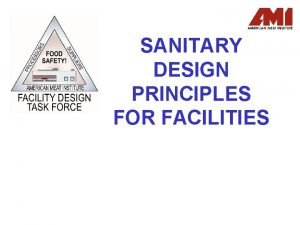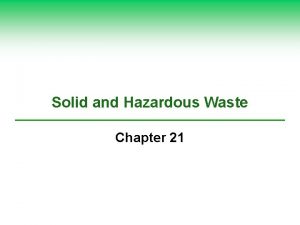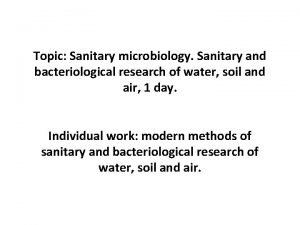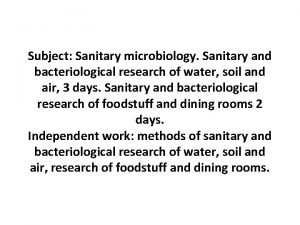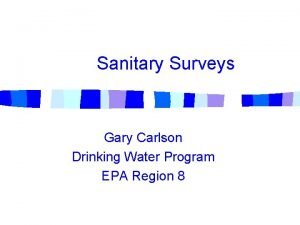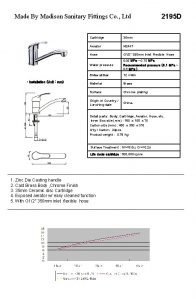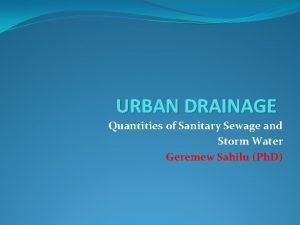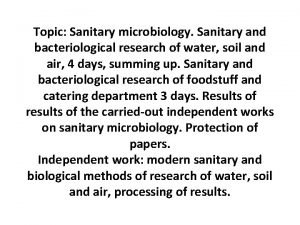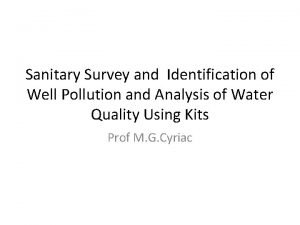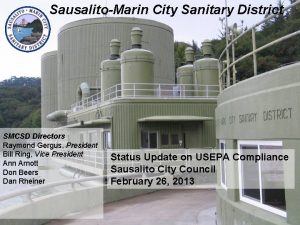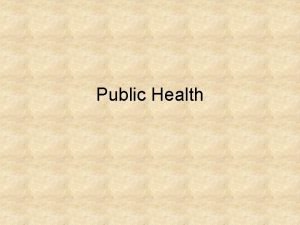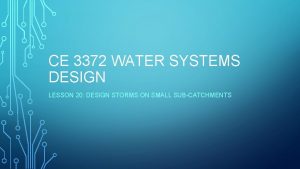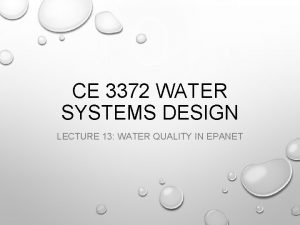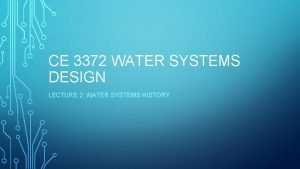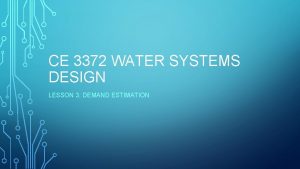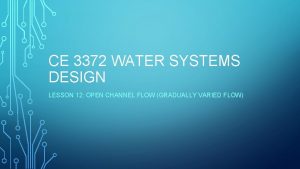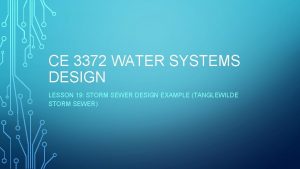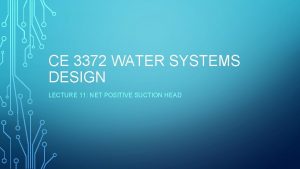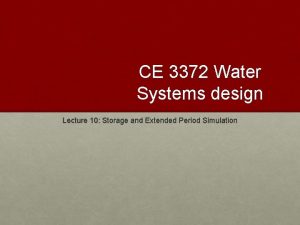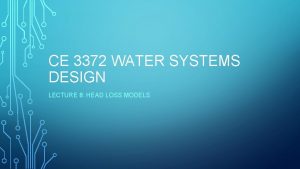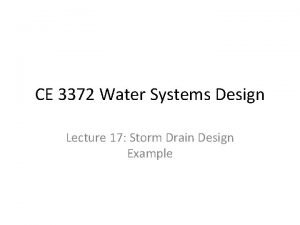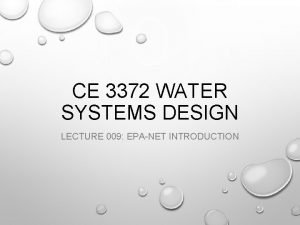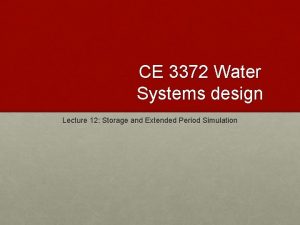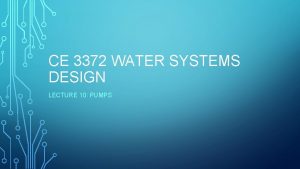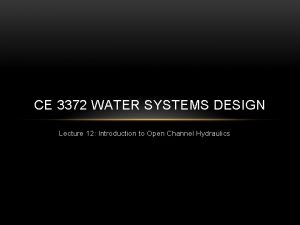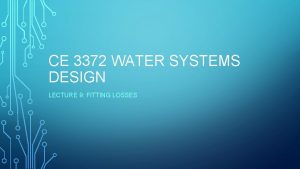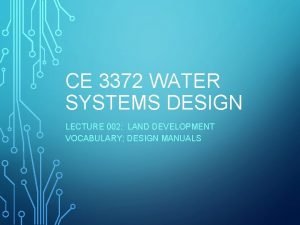CE 3372 WATER SYSTEMS DESIGN LESSON 24 SANITARY






























- Slides: 30

CE 3372 WATER SYSTEMS DESIGN LESSON 24: SANITARY SEWER SYSTEMS

COLLECTION SYSTEMS • Collection systems (sewers) are used to collect wastewater and deliver it to a common location. • In the case of sanitary wastewater (sewage) that location is some kind of treatment facility • For storm-water, that location can often be an outfall to a receiving stream.

COLLECTION SYSTEMS • Collection systems play an important role in the control of water quality, • Concentrate certain kinds of potential non-point discharges into point discharges, which can be managed more efficiently.

SOURCES • Point sources – you can point to them! • Non-point sources – distributed over an area.

SEWER TYPES • Sewers are an important class of open channels, typically subsurface, that are used to transport wastewater to its final release point back into the environment. • The design life of sewers is usually on the order of 50 years, so design must account for expansion and population growth.

SEWER TYPES • Sanitary sewer systems — individual discharges are collected, concentrated (in • • the volume sense), and delivered to a treatment plant for further processing. Storm sewer systems — individual discharges are collected, concentrated, and delivered to a receiving water. Combined sewer system (CSS) — A sanitary system designed to also collect storm-water. New combined systems are not built in the USA; older cities that were comparatively large in the 1880’s represent the remaining combined systems.

SEWER TYPES • Combined sewer systems in USA:

SEWER TYPES • The categories share similar hydraulics, namely that of open channel flow, and topologically are similar (comprised of pipes, boxes, junctions, and lift stations) so many design principles are interchangeable, although the sewer’s purposes are different.

SEWER TYPES • A sanitary system is to protect public health by isolating wastes from the environment until they can be treated and the reclaimed water released.

SEWER TYPES • A storm system is to protect public health by removing nuisance flooding and keeping infrastructure serviceable during all but the most severe weather • recently (last two decades) storm sewer systems have been called upon to confer water quality benefit, as they are the collectors that capture non-point pollution.

SANITARY SEWER DESIGN • Sanitary sewers are pipeline systems underground that collect and transmit sewage from distributed sources to a central location. • The pipes are typically operated as open channels, that is the pipes are not supposed to flow full, and gravity is the driving force. • In some portions of the system, the sewage has to be lifted to maintain flow towards the central plant • these locations are called “lift stations”, and sewage on the discharge side of the pump flows in a pipe called a “force main” until the pipe returns to open flow, it is then just a sewage pipe.

SANITARY SEWER DESIGN • The rules of design are governed by federal law, state law, and in most cases municipal law. • These various laws, codes, and guidelines prescribe materials, joints, labeling, etc. • Nearly all sewer systems must be engineered (i. e. a PE is involved with the design), or at least designed by a licensed professional (the professional may not be an engineer in smaller on-site systems, but the design will be stamped with that professional’s credentials. )

SEWAGE CHARACTERISTICS • Sewage behaves hydraulically as water. • 5 percent solids by mass is typically the upper limit of raw sewage • by volume the percentage is much smaller, perhaps as small as 0. 05 percent.

SEWAGE CHARACTERISTICS • Solids collect in the system Cleaning of sewers circa 1800’s. Cities like Paris, New York, London, etc. have large diameter sewers that probably still need personnel access.

SEWAGE CHARACTERISTICS • The design engineer is concerned with the sewage quality insofar as it affects corrosion and safety to the maintenance personnel. • For example, in the Texas code, there is some discussion of corrosion and odor issues:

SEWAGE CHARACTERISTICS For example, in the Texas code, there is some discussion of corrosion and odor issues: 1. Corrosion potential: (a) (b) If a pipe or an integral structural component of a pipe will deteriorate when subjected to corrosive internal conditions or if a pipe or component does not have a corrosive resistant liner installed by the pipe manufacturer, the report must demonstrate the structural integrity of a pipe during the minimum 50 year design life cycle. A pipe must have an appropriate lining if the corrosion analysis indicates that corrosion will reduce the functional life of the pipe to less than 50 years.

SEWAGE CHARACTERISTICS For example, in the Texas code, there is some discussion of corrosion and odor issues: 1. Odor Control. (a) An owner shall determine if odor control measures are necessary to prevent a wastewater collection system from becoming a nuisance, based upon the potential of the wastewater collection system to generate hydrogen sulfide. (b) A potential odor determination must include the estimated flows immediately following construction and throughout a system’s 50 -year expected life cycle.

SEWAGE QUANTITY Sewage quantity is estimated in a similar fashion as water demand. §Small residential service area flows are estimated based on population or equivalent residential units and per-person contribution to wastewater generation. §Larger service area flows are estimated from land use (zoning), anticipated population, and similar nearby measured flows. Sewage is not measured routinely, but short-term studies (2 -months) are within the capabilities of most jurisdictions, flow measurement is by weirs, magmeters, and acoustic-Doppler profiling.

SEWAGE QUANTITY For example, in Texas the design flow basis is: §An owner must design a wastewater collection system to handle the transport of the peak dry weather flow from the service area, plus infiltration and inflow. §The flow calculations must include the details of the average dry weather flow, the dry weather flow peaking factor, and the infiltration and inflow. §The flow calculations must include the flow expected in the facility immediately upon completion of construction and at the end of its 50 -year life.

SEWAGE QUANTITY Some further requirements are: Capacity Analysis. § § § An owner must ensure that a wastewater collection system’s capacity is sufficient to serve the estimated future population, including institutional, industrial, and commercial flows. An owner must include in the report the calculations that demonstrate that the hydraulic capacity of a collection system includes the peak flow of domes- tic sewage, peak flow of waste from industrial sites, and maximum infiltration rates. A collection system must be designed to prevent a surcharge in any pipe at the expected peak flow.

SEWAGE QUANTITY Some further requirements are: Capacity Analysis. §The minimum diameter allowed for a gravity pipe is 6. 0 inches. §Connecting storm water drains to a collection system is prohibited. §An owner may use the data from an existing collection system. In the absence of existing data, a design must use data from a similar system or as described below: § The sizing of pipe for a new collection system must be based on an engineering analysis of initial and future flows. § A new collection system design must be sized for the peak flow, which is based on the estimated daily sewage flow contribution as shown in Figure 4

SEWAGE QUANTITY

SEWAGE QUANTITY Some other ways to estimate sewage flow in Texas includes formulas such as the Equation below from the Texas Administrative Code based in number of bedrooms (an equivalent residential unit (ERU) approach). where: Q = flow in gallons per day , X = per capita wastewater production in gallons per day , B = number of bedrooms.

SEWAGE QUANTITY Yet another equation in the code is: • • • where: Q = flow in gallons per minute. A = rate factor. N = number of equivalent dwelling units served. B = factor of safety.

SEWAGE QUANTITY • Yet another equation in the code is: • • • where: Q = flow in gallons per minute. A 1 = rate factor. P = population served. B = factor of safety.

SEWAGE QUANTITY • Other jurisdictions will have similar kinds of estimate guidelines. • One important note, the units of each of these equations, which have similar mathematical structure, are quite different. One produces estimates in gallons/day, while the other two are gallons/minute.

MODELING SEWERS IN SWMM • Collection system – pretty much the same as storm water • • • Treatment plant – uncommon but SWMM can be used to model hydraulics going through a plant reactors == rectangular channels of appropriate length sumps == storage nodes pumps == pumps could be useful for drawing HGL through a plant. Head losses between unit processes may take some trial-and-error to enter the head loss terms.

INFLOW AND INFILTRATION • Inflow is direct connections to sanitary sewers • • Roof gutters French drains • Such connections are not supposed to be allowed • Infiltration is leakage into sanitary sewers • • • Cracks in pipe; high water table Leaks at joints Leaks at junction boxes

INFLOW AND INFILTRATION • Inflow • Infiltration

INFLOW AND INFILTRATION • Inflow (Red) • Infiltration (Blue)
 Proxyvo
Proxyvo Water and water and water water
Water and water and water water Sanitary design principles
Sanitary design principles Shallow well and deep well diagram
Shallow well and deep well diagram Castelli sanitary
Castelli sanitary Sanitary landfill
Sanitary landfill What is coving servsafe
What is coving servsafe Sanitary supplies wholesaler
Sanitary supplies wholesaler Las gallinas valley sanitary district
Las gallinas valley sanitary district Retainer with pontic
Retainer with pontic Sanitary microbiology
Sanitary microbiology Sanitary microbiology
Sanitary microbiology Sanitary microbiology
Sanitary microbiology Epa sanitary survey
Epa sanitary survey Castelli sanitary
Castelli sanitary Fanning formula
Fanning formula Sanitary microbiology
Sanitary microbiology Sanitary plate
Sanitary plate Sanitary registration in el salvador
Sanitary registration in el salvador Cross connection servsafe
Cross connection servsafe Sanitary survey
Sanitary survey Dome shaped pontic
Dome shaped pontic Sanitary landfill
Sanitary landfill What is visual pollution definition
What is visual pollution definition Pasco sanitary landfill
Pasco sanitary landfill Smcsd
Smcsd The sanitary report 1842 bbc bitesize
The sanitary report 1842 bbc bitesize Decision support systems and intelligent systems
Decision support systems and intelligent systems Dicapine
Dicapine Embedded systems vs cyber physical systems
Embedded systems vs cyber physical systems Engineering elegant systems: theory of systems engineering
Engineering elegant systems: theory of systems engineering


